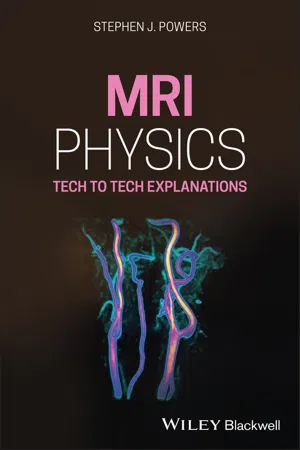
- English
- ePUB (mobile friendly)
- Available on iOS & Android
About this book
MRI PHYSICS
TECH TO TECH EXPLANATIONS
Technologists must have a solid understanding of the physics behind Magnetic Resonance Imaging (MRI), including safety, the hows and whys of the quantum physics of the MR phenomenon, and how to competently operate MRI scanners. Generating the highest quality images of the human body involves thorough knowledge of scanner hardware, pulse sequences, image contrast, geometric parameters, and tissue suppression techniques.
MRI Physics: Tech to Tech Explanations is designed to help student MRI technologists and radiotherapists preparing for Advanced MRI certification examinations to better understand difficult concepts and topics in a quick and easy manner.
Written by a highly experienced technologist, this useful guide provides clear and reader-friendly coverage of what every MR Technologist needs to know. Topics include safety considerations associated with the magnetic field and RF, pulse sequences, artifacts, MRI math, the much-feared gradients, and I.V. contrast.
- Provides basic guidance on safety considerations, protocols options, critical thinking, and image contrast optimization
- Simplifies the challenging topic of MRI physics using straightforward language and clear explanations
- Covers content for American Registry of Radiologic Technologists (ARRT) and Continuing Qualifications Requirements (CQR) exams
- Features numerous illustrations and photographs of various MRI concepts, pulse sequence design, artifacts, and the application of concepts in clinical settings
MRI Physics: Tech to Tech Explanations is a must-have resource for the experienced and training MRI technologist, medical students, and radiology residency rotations.
Frequently asked questions
- Essential is ideal for learners and professionals who enjoy exploring a wide range of subjects. Access the Essential Library with 800,000+ trusted titles and best-sellers across business, personal growth, and the humanities. Includes unlimited reading time and Standard Read Aloud voice.
- Complete: Perfect for advanced learners and researchers needing full, unrestricted access. Unlock 1.4M+ books across hundreds of subjects, including academic and specialized titles. The Complete Plan also includes advanced features like Premium Read Aloud and Research Assistant.
Please note we cannot support devices running on iOS 13 and Android 7 or earlier. Learn more about using the app.
Information
1
Hardware: Magnet Types and Coils
Magnets
- Permanent. These are rare to almost nonexistent today. They are made up of brick‐sized magnets that, when placed in the right pattern, combine to make a magnetic field strong enough to image with. These magnets are large, heavy, and have a weak B0 field so signal‐to‐noise ratio (SNR) is at a premium. They cannot however be turned off.
- Resistive. These consist of a large coil of wire with a lot of electricity passing through it. The amount of electricity circulating is sufficient to make a magnetic field strong enough to image with. These are usually 0.5–0.7 T. They also generate a lot of heat from electrical resistance in the wire.
- Superconducting. These are resistive magnets but with one major difference. The magnet is cooled with liquid helium, a cryogen. The cryogen decreases electrical resistance in the wires that make up the magnet. The loss of resistance from cooling enables more current to flow so stronger magnetic fields are possible. Typical field strengths are 1–4T. Research magnets can be as strong as 7–9 T. Stronger magnetic fields also come with a larger fringe field compared to the lower‐power fields. Think of the fringe field as being like the “Scatter Radiation” in x‐radiography. The magnetic field is not solely confined to the scanner. Magnetism picks up rapidly as you get closer to the bore.
Teaching Moment:
The Superconducting Magnet
Coils

- Surface coil: spine
- Saddle coil: knee, foot/ankle
- Helmholtz: shoulder (Figure 1.2)
- Bird cage (quadrature): brain (Figure 1.3).
Table of contents
- Cover
- Table of Contents
- Title Page
- Copyright Page
- Dedication Page
- About the Author
- Preface
- Acknowledgements
- Introduction
- 1 Hardware: Magnet Types and Coils
- 2 The Basics
- 3 Image Weighting
- 4 Introduction to the Basic Pulse Sequences
- 5 Multi Echo Spin Echo Sequence
- 6 Tissue Suppression
- 7 The Gradient Echo Sequence
- 8 Gradient Echo Magnetic Resonance Angiography
- 9 k‐Space
- 10 Echo Planar Sequences
- 11 Geometric Parameters
- 12 Image Artifacts
- 13 Gradients
- 14 MRI Math
- 15 Parallel Imaging
- 16 IV Gadolinium
- Glossary
- Suggested Reading
- Index
- End User License Agreement